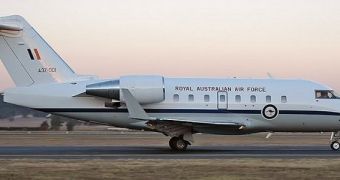Officials at the Boeing Company announce that the first version of their new advanced aircraft, called the Maritime Surveillance Aircraft (MSA), has just flown successfully for the first time. The asset was announced last year, and the company stuck to its word of achieving first flight in early 2014.
The purpose of this particular flight was to verify the airworthiness of this design, which relies on the use of a modified Bombardier Challenger 604 business jet. The aircraft is outfitted with the same technologies currently being developed for the former Multimission Maritime Aircraft (MMA), now designated Boeing P-8 Poseidon.
The main differences between the two are size and cost. The P-8 is developed on the Boeing 737 Next Generation platform, while the MSA is based on the much smaller Bombardier airframe. The latter is heavily modified by Boeing contractor Field Aviation, which is responsible for creating the necessary modifications so that all capabilities can be transferred from the P-8 to its smaller brother.
Boeing considers this first flight an important milestone in its efforts to provide the United States Navy with assets capable of anti-submarine warfare (ASW), anti-surface warfare (ASUW), shipping interdiction, and electronic intelligence (ELINT) roles. The MSA is intended as a lower-risk, more-cost-efficient variant of the P-8.
Its main roles will probably revolve around search and rescue missions, coastal and border security, and anti-piracy and anti-narcotics patrols, both at home and abroad. The MSA Bombardier first flew on February 28, 2014, for around four hours. The test flight occurred at Pearson International Airport in Toronto, Canada.
“We accomplished everything we set out to achieve. The aerodynamic performance was right on the money and even with the additional aerodynamic shapes, such as the radome, the demonstrator performed like a normal aircraft. The control and handling were excellent,” commented Field Aviation pilot Craig Tylski after the flight, as quoted by SpaceMart.
Over the next couple of months, Boeing engineers will continue to conduct additional airworthiness flights, meant to iron out any details that might affect flight performances. Once this stage in the development process is done, the aircraft will be delivered to a facility in Seattle, Washington, where MSA mission systems are to be installed for the first time.
According to the company and the US Navy, the basic configuration for the MSA will include an active electronically scanned array multi-mode radar, an electro/optical/infrared sensor, electronic support measures, a communications intelligence sensor, and an automated identification system. All of these technologies have already been proven during P-8's development.
The reason why Boeing was able to move so fast in developing the MSA on the Bombardier airframe is that rapid prototyping was enabled via its advanced technology arm, Phantom Works. This is the same group responsible for aircraft such as the X-51 hypersonic vehicle and the X-37 space plane.

 14 DAY TRIAL //
14 DAY TRIAL //